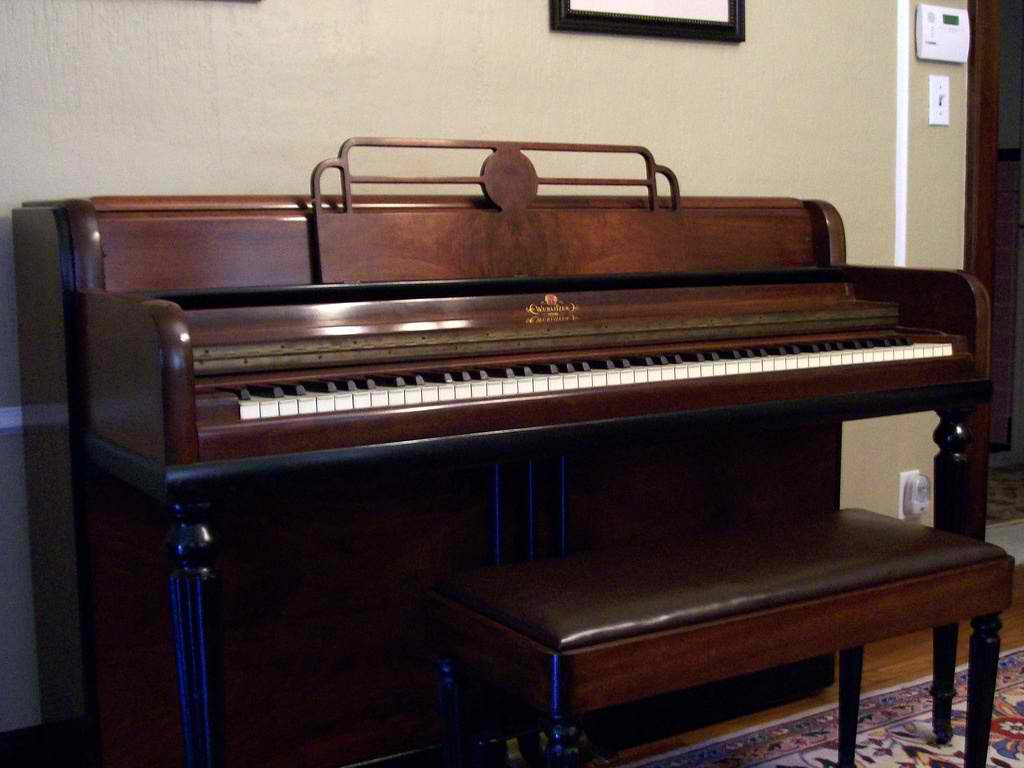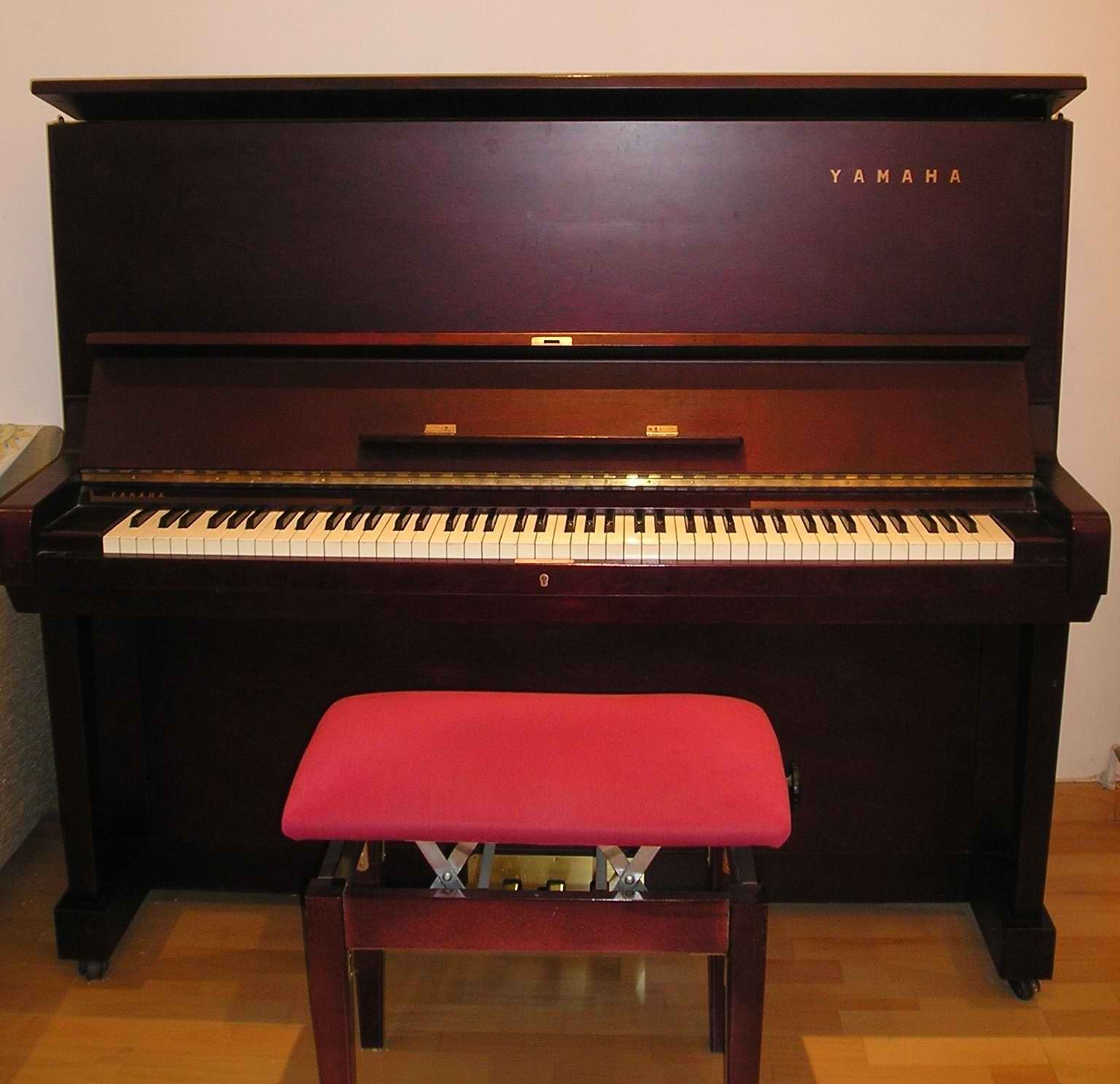What’s the Difference Between Types of Vertical Pianos?
You’re probably familiar with what a grand piano looks like. In a grand piano, the frame and the strings are both horizontal, accounting for the piano’s large body and full, rich sound.
All other pianos that are not grand pianos are considered ‘vertical’ pianos. In these instruments, the frame and the strings are vertical, and the hammers move horizontally. Hence, the piano’s vertical position.
There are four different types of vertical piano, listed from shortest to tallest: spinet, console, studio and upright. Each type has a slightly different look and sound. We’ll explain the differences between each type to help you narrow down which instrument might be best for your family.
Spinet
A spinet piano is typically less than 40 inches tall, measured from the floor to the top of the lid. The top of the piano comes just a few inches above the keys, and the action is located below, operated by vertical wires that are attached to the backs of the keys.
Spinet pianos are a great option for those with limited space. They’re also typically more inexpensive than their larger counterparts.
While the spinet will certainly serve its purpose for you to learn and enjoy playing the piano, some professional musicians feel the sound quality and playability is inferior to that of larger models due to their small size and the configuration of the keys and strings.
Console
A console piano is the next size up from the spinet, typically measuring between 40 and 44 inches tall. In this style of instrument, the action sits directly on top of the keys, with smaller hammers and the strings stretching downward.
The sound quality of the console piano is satisfactory for most home pianists and hobby players.
Studio
A studio piano is between 44 and 47 inches tall and is similar to a console piano, with a slightly different feel and location of the action. A studio features a full-size action sitting directly on the keys.
In our opinion, a studio piano produces a wonderful quality and richness of sound that rivals that of a grand piano.
Upright
This is the instrument many of us envision when we think of a traditional piano—you may even have memories of one sitting in your grandparents’ house. The tallest of the vertical pianos, the upright is a beautiful instrument with a full sound quality and easy playability.
The type of piano you choose is a matter of personal preference; one person’s opinion of which type is superior shouldn’t be a deciding factor in which piano you buy. Instead, Cooper Piano’s team of knowledgeable staff members is here to help you understand what makes each instrument unique, helping you test each model until you find the one that’s just right for you.










Is there a upright grand piano and just an upright or are all uprights considered grands.
Upright Grand was a term used in the early part of the 20th century for tall pianos usually over 52″. Upright pianos come in four types, Spinet, Console and Studio and Upright. They are not grand pianos.
Blake,
I think you mean to say “Vertical” pianos come in four types…Not “Upright” pianos come in four types. If someone was posting for sale an “Upright” piano, I’d be sorely disappointed to go there and find a spinet. You should never refer to every “vertical” piano as an Upright.
We have an Aston Weight “Upright Grand”, a brand name this small craftsman piano company used. They used the term, perhaps not technically correct, to describe the large soundboard, similar to that of an upright, made possible by the use of a full iron string frame. I must say the tone and volume is more than adequate for home use, and the use of iron rather than wood bracing results in a piano which rarely needs tuning. Mine was purchased new in 1982 from a San Diego dealer
who transported several from the Salt Lake City manufacturer.
Is the sound quality of a studio better than an upright. Thank you.
Looking for a a new upright grand piano that can be shipped to Lafayette, CA.
Ir cannot be over 39 inches wide.
Pianos usually are 56+ inches wide
My husband insists that all measurements are from floor to top of the piano. Aren’t they measured from floor to top of the lid covering the keys. Help?
I have a 1981 Baldwin “spinet” (I think?). The serial number is 1262378. The keys are not white. They are a medium tan color, which goes very well with the pecan wood finish (I think?) Did Baldwin offer tinted keys when this piano was new or are they just aged like this for some reason? The color of the keys are all exactly uniform when compared to each other. Actually, this is what attracted me to this used piano in the first place, because the keys were unique and match the wood finish so well.
Many years ago I had a friend who had an upright piano but it was a bit shorter (not a spinet) and was missing the bottom and top octaves. I have been looking for one for over 30 years but I don’t know what it was called. Ever heard of this? It looked like my upright Cable, just smaller. Could it have been a salesman sample ? It is driving me nuts!
The ones missing octaves are “ship pianos” like Marco Polo by Kawai, meant for more cramped conditions.
I’m looking at a 52 inch Solomon vertical piano, but can’t find wh made it.
Hellow
I want sell Antique J&J Hopkinson piano. Almost 100 years old antique. Made in London. Good working condition. Are you interested to buy ?? Please reply me ??
please, is there a piano comparable to a Grinnell upright from the 1920s. I need a current price for replacement value on a personal property claim loss for insurance company.
All upright/ verticals share the Same mechanism – the way hammers hit the strings, different than the grands…even baby grands. Just think about the strings are laying flat vs vertical…
We love the mechanics of pianos!
100 or free…
My 10 year old is finishing piano Suzuki book 2 and has been learning on an electric piano since covid. We are looking to get a smaller size upright and there is a really good condition 1938 Story & Clark Spinet we are looking to get from a neighbor. Is it worth it or should we not even bother and just get a larger piano for her to really get the feel/sound of piano playing? I am hoping for Spinet size due to space to start….
If you are considering a used piano, you should always ask the seller if there are any special needs that you need to know about before you make the final purchase. You should also be prepared to spend money to help make the piano a better tool for your lessons.